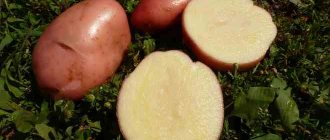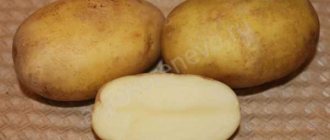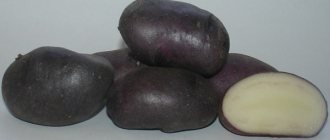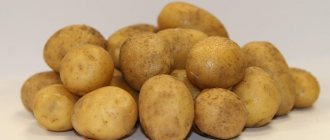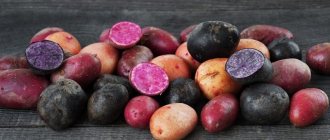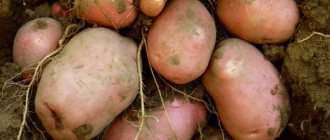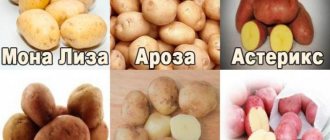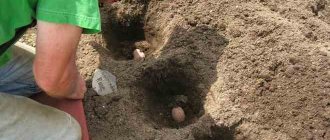Vegetable growing » Potatoes
0
2339
Article rating
Kira Stoletova
New potato varieties are added every day. Breeders are trying to develop the best types of vegetables that will be resistant to diseases and climatic conditions. Silvana potatoes are just such a variety. It tastes great and is easy to care for.
Description of Silvana potatoes
Silvana potatoes: variety description, photos, reviews
FermoVed.ru » Vegetable growing » Potatoes » Description of Silvana potatoes
New varieties of potatoes are replenished with new products every day. Breeders are trying to develop the best types of vegetables that will be resistant to diseases and climatic conditions. Silvana potatoes are just such a variety. It tastes great and is easy to care for.
Description of Silvana potatoes
Characteristics of the variety
The variety Silvana is medium-fruited, suitable for table use. Potatoes are included in the State Register for the Central and Volgo-Vyatka regions. Potato yield ranges from 170-448 c/ha. Ripening time is 90-110 days. The root system is well developed.
Description of the plant
Description of the plant – the bush is quite tall, of an intermediate type. Stems are straight. The leaves are small and green in color. The edges are a little fibrous. During the ripening period, the plant produces large, red flowers.
Description of root vegetables
The weight of one fruit is 92-148 g. Silvana potatoes have a round shape. The skin is smooth, yellow in color. The flesh is also yellow. There are eyes of medium size, not deep. Potatoes contain starch in the range of 13.6-15.3%, so the vegetable does not overcook and retains its ideal shape.
Marketability is 84-96%, these are good indicators for potatoes. Keeping quality 91%. The potato tastes great. It will make very tasty dishes.
Benefits of potatoes
The characteristics of potatoes are positive. Gardeners highlight the following qualities:
- good keeping quality;
- great taste;
- ideal presentation, so the vegetable can be grown for sale;
- ability to transport without damage;
- high yield;
- When cooking, the fruits do not become soft;
- strong immunity to potato cancer and golden nematode;
- The variety has no disadvantages.
Preparing soil and tubers
To get a large and high-quality harvest, the gardener must know the rules and conditions of cultivation. Planting material and soil are prepared for planting. They begin to do this in the fall. The ground is cleared of remnants of tops and weeds.
The tubers themselves are transferred from the cellar to a bright place a month before planting so that they sprout. The tubers are treated with a growth stimulator and special agents against possible parasites.
Landing rules
Following the rules will help increase productivity
It is best to plant potatoes in early May so that the soil warms up well. It is worth taking into account the terrain and climate, so the dates may shift slightly. The soil should not be very cold or wet. An area where legumes or winter crops previously grew is ideal for planting. Gardeners do not recommend planting vegetables in the same place every year.
There are several mandatory rules that every gardener must follow during planting.
- There is no need to bury the tubers very deeply. The higher you plant them, the faster they will germinate.
- If you use the ridge planting method, it should not be more than 10 cm. The distance between the bushes is 25-30 cm.
- At the time of planting, wood ash is poured into each hole. It promotes high-quality potato growth.
- The area should be well lit and evenly lit. The crop will receive the same amount of heat and will be able to begin to form fruit and grow at the same time.
Plant care
A week after planting potatoes in the ground, you need to very carefully loosen the soil around the bushes. This is necessary to remove possible weeds and allow air into the plant. They also loosen the soil after each watering. In addition, the soil is fed several times throughout the growing season with humus, mullein and bird droppings. Frequent watering can kill the plant, so once every 10 days will be enough. Irrigation should be carried out abundantly, but not to great depth.
When the plant grows 20 cm, it needs to be hilled. After this, hilling is carried out every time the soil ridge is leveled to the ground. The main thing is to be careful with the stems, because they are very fragile. If a bush is accidentally broken, it will grow much slower, and this will reduce the harvest. It is recommended to use manure as fertilizer. Mineral fertilizers can be added, but very carefully, since excess will have a bad effect on the taste of potatoes.
Diseases and parasites
The Silvana variety is resistant to many diseases. It perfectly tolerates potato cancer and golden nematode. It is also moderately resistant to late blight and common scab. Therefore, in order to protect the plant from the appearance of these diseases, it is necessary to loosen the soil and spray the planting material with a growth stimulant before planting.
Conclusion
The Silvana potato variety is popular among gardeners. It is not demanding in care and is resistant to almost all diseases. High yield and quality of fruits depend on growing conditions.
Article on the topic: Potato variety “Golubka” - description and photo
Potato varieties - Potato Riviera (Holland)
Potatoes 2014. Varieties. Homemade digging.
Silvana La Rossa at lunch
The potatoes have a wonderful taste and retain their shape while cooking. It can be baked, fried and stewed. She will decorate every holiday table. A high marketability indicator makes it possible to put the vegetable up for sale.
Sylvana
General characteristics: mid-early table variety of Dutch selection with beautiful, slightly oblong tubers. Adapts well to soil and climate. Moderately resistant to late blight and other potato diseases.
Ripening period (vegetation): 70-85 days.
Starch content: 13.6-15.3%.
Weight of marketable tubers (grams): 92-148.
Number of tubers in a bush: 7-14 pieces.
Productivity (c/ha): 170-374 (maximum – 448).
Consumer qualities: good and excellent taste, culinary type AB (suitable for salads and making fried potatoes).
Keeping quality (storage ability): 91%.
Peel color: yellow.
Flesh color: yellow.
Preferred growing regions (RF): Northwestern, Central, Volgo-Vyatka.
Disease resistance: the variety is resistant to golden potato cyst nematode and potato cancer, moderately resistant to tubers and moderately susceptible to late blight on tops, moderately resistant to common scab and viruses.
Features of cultivation: germination is recommended, standard agricultural technology, responds well to watering.
Other: the originator of the Silvana potato variety is HZPC Sadokas (Netherlands).
Description of the Silvana potato variety
Characteristics of the Silvana potato variety.
Originator: HZPС Sadokas.
Mid-early potato variety, suitable for table use. The taste is good and excellent.
The plant is tall, intermediate type, semi-erect. The leaf is medium sized, open, light green to green. The undulation of the edge is weak. The corolla is medium to large in size, red-violet.
The tuber is round with eyes of medium depth. The peel is smooth, yellow. The pulp is yellow. The weight of the marketable tuber is 92-148 g. The starch content is 13.6-15.3%.
The variety is resistant to the pathogen of potato cancer and golden potato cyst nematode. According to the originator, it is moderately resistant to the causative agent of late blight and common scab.
The marketable yield of the Silvana potato variety is 170-374 c/ha, at the level of the Elizaveta standard and 99 c/ha lower than the Nevsky standard. The maximum yield is 448 c/ha, 188 c/ha higher than the Nevsky standard (Tula region). Marketability 84-96%. Keeping quality 91%.
The potato variety is included in the State Register for the Central and Volga-Vyatka regions.
Sifra and Silvana - potato varieties with high potential
Forecasters warned back in the spring that 2021 would be a difficult year for plant growers, and their forecasts were confirmed: summer and autumn turned out to be cold and rainy. However, despite the bad weather, the HZPC varieties showed excellent results. I would especially like to mention two varieties - Sifra and Silvana.
in 2021 will hold various events throughout the country, so be sure to follow the news on the company’s website: www.hzpc-sadokas.ru
In the 2017-2018 season, the production of elite and reproduction seed potatoes of the Sifra and Silvana varieties was carried out on a contract basis on the basis of professional seed farms located in the Nizhny Novgorod and Leningrad regions.
At the YugAgro exhibition, which will be held from November 28 to December 1, 2017. in Krasnodar, all visitors will have the opportunity to independently evaluate the above varieties, as well as a number of other promising varieties bred by HZPC Holland BV. In addition, they will be able to ask questions about growing potatoes and discuss the prospects for possible cooperation with company representatives at stand No. B651, in Pavilion 2 .
For any questions, please contact us by phone: +7 (812) 603-03-05 and email: This email address is being protected from spambots. You must have JavaScript enabled to view it.
Landing
Silvana potatoes are planted in the temperate zone from the first days of May. The soil should warm up to 12 degrees, the air temperature at 14-16 degrees. The reference point is a folk sign - the opening of birch buds.
Potatoes are not planted for more than 2 seasons in a row in 1 place. They observe crop rotation, cultivating vegetables after root vegetables, pumpkins, cucumbers, and salad greens. Good predecessors are cruciferous and legume species.
Various planting techniques are used. Classic rows of holes using a shovel are practiced on level ground with sufficient rainfall. They are planted in ridges in cool regions for quick warming, when groundwater is close. The trench method is effective in areas with sandy loam and sandy soils.
There are 5-7 plants per 1 m2. The distance between holes is 30-35 cm in a row, between rows - 60-70 cm. The depth of holes varies from 6 cm on dense soils to 12 cm in sand. As fertilizers, 30 g of superphosphate and 10 g of potassium salt are applied per 1 m2 in advance (during autumn plowing).
Description of culture
Potatoes are the second bread. This is the most valuable garden crop and an important food product.
Potato is a tuberous plant . The growing season takes place in one summer, starting with the germination of tubers and ending with the formation of new mature tubers. The plant forms a semi-spreading or spreading bush 60-100 cm high, consisting of 4-8 stems . Potato leaves are green, pubescent, strongly dissected; The root system is fibrous and poorly developed. Flowers are collected in inflorescences on one common peduncle. Flower color is one of the varietal characteristics. The corollas of flowers can be painted white, pink, blue-violet, or have various shades of blue .
The fruit is an oval or spherical berry with small seeds. Potatoes are grown from seeds only in scientific institutions. Potatoes can be propagated at home by sprouts, cuttings and tubers.
The tubers have eyes with 3-5 buds. More viable eyes are located on the apical part of the tuber.
When the bush reaches 10-20 cm, stolons develop in the underground part of the stem from axillary buds - underground shoots 2-3 mm thick, white. In late varieties, the stolons are long - up to 50 cm, in early varieties - short - up to 10-20 cm. As soon as the stolons stop growing in length, their tops thicken and tubers form.
Article on the topic: Potato variety “Music” - description and photo
All nutrients are “collected” in potato tubers.
The second varietal characteristic is the color of the peel. It can be white, light yellow, pink, red, red-violet and blue-violet.
The pulp is most often white and creamy, sometimes having a yellow tint . Remember that the taste of potatoes does not depend on the color of the pulp. The taste depends on the content of biochemical components - amino acids, sugars, carotenoids, etc. The color of the tubers depends on the content of vitamins A and B2. Tubers with yellow flesh are richest in these vitamins. Today, varieties with blue-violet, red and almost black tubers have appeared on the market.
Growing and care
After germination of the seedlings a week later, the beds are loosened between the rows and weeds are removed. Hilling is carried out 3 weeks after germination (on the eve of the first feeding). Half of the bushes are sprinkled with earth. This will protect against return frosts and pest invasions.
When the tops grow to 21-24 cm, the bushes are hilled a second time.
Water moderately; frequent watering can cause rot and blackleg. During the season, 2-3 moisturizers are enough. The depth of soil saturation is 40-50 cm. The following fertilizers are used:
- organic solutions;
- nitrogen compounds (urea, urea, nitroammophosphate);
- superphosphate, phosphate mixture;
- potassium salts;
- complexes (Ohm, Bulba, Speedfol).
Seed material is selected immediately from powerful, healthy, most productive bushes. They are dried in the shade and subjected to vernalization for a week.
How to choose the right potato varieties
A bountiful potato harvest can only be obtained after choosing the right variety. All potato varieties have their own characteristics and differ in early ripening, taste, starch content, yield, and resistance to adverse weather conditions.
When choosing a variety, consider some important rules:
- Remember that the same variety can produce different yields in different years and on different soils. Therefore, to obtain a guaranteed harvest, 3-4 varieties must be planted annually on the site;
- To obtain a high yield, you need to select different varieties according to ripening time. All varieties, depending on the ripening period, are divided into early, mid-early, mid-ripening, mid-late and late-ripening. The amount of cultivation of individual groups largely depends on the region of growth: in regions where early frosts are observed, late varieties are grown in small quantities. In cold areas, limit planting to mid-late and mid-season varieties. Early and mid-early varieties should predominate in the northern and northwestern regions. In the south and southeast, both varieties can be grown, depending on the needs of the gardener.
- It is important to regularly update the seed fund . Give main preference to local released varieties. They have a number of advantages: they are better adapted to climatic and soil conditions, more productive, and resistant to major diseases and pests.
- Depending on the region, every 2-5 years the seed material must be systematically replaced with healthy seed tubers. Give preference to the elite, the first reproduction, as well as new productive varieties.
The main advantages and disadvantages of the variety
The undoubted advantages of Dutch seed potatoes include:
- high productivity;
- short growing season, so you can harvest two crops per season;
- can be collected not only by hand, but also using a potato digger;
- good taste;
- high resistance to potato cancer, nematodes, potato Y-viruses;
- versatility of culinary use;
- good presentation and optimal tuber size;
- keeping quality over 95%;
- easy adaptation to weather conditions of different climatic zones.
The Dutch potato variety also has disadvantages:
- if the harvest is not harvested on time, the peel of most varieties becomes very rough;
- all Dutch varieties cannot grow in one place for more than 3 years in a row;
- you need to often purchase new planting material, since in 2-3 years the variety loses its taste. In addition, if you use last year's harvest as planting material, the tubers of the future harvest will become smaller.
Note! Almost all Dutch potatoes are not resistant to top blight


